 |
 |
 |
| |
Prognostic value of viral eradication for major adverse
cardiovascular events in hepatitis C cirrhotic patients. ANRS CO12 CirVir Cohort
|
| |
| |
Reported by Jules Levin
EASL 2017 April 19-23 Amsterdam Netherlands
Patrice Cacoub1,2,3,4*, Pierre Nahon5,6,7*, Richard Layese8, Valérie Bourcier5, Carole Cagnot9, Patrick Marcellin10, Dominique Guyader11, Stanislas Pol12, Dominique Larrey13, Victor De Lédinghen14, Denis Ouzan15, Fabien Zoulim16, Dominique Roulot17, Albert Tran18, Jean-Pierre Bronowicki19, Jean-Pierre Zarski20, Ghassan Riachi21, Paul Calès22, Jean-Marie Péron23, Laurent Alric24, Marc Bourlière25, Philippe Mathurin26, Jean-Frédéric Blanc27, Armand Abergel28, Lawrence Serfaty29, Ariane Mallat30, Jean-Didier Grangé31, Pierre Attali32, Yannick Bacq33, Claire Wartelle34, Thông Dao35, Dominique Thabut1,36, Christophe Pilette37, Christine Silvain38, Christos Christidis39, Dominique Capron40, Gérard Thiefin41, David Zucman42, Vincent Di Martino43, Corinne Isnard Bagnis1,44, Marianne Ziol7,45,46, Angela Sutton46,47, Eric Letouze7, Françoise Roudot-Thoraval8, Etienne Audureau8 for the ANRS CO12 CirVir group.
"At endpoint, a SVR was noted in 4 (6.9%) who did versus 302 (37.8%) patients who did not present a MACE (HR = 0.39 [0.13; 0.95], P = .036). In multivariate analysis, SVR was associated with a decreased risk of MACE (HR = 0.35 [0.09; 0.97], P = .044), while Asian ethnic origin, arterial hypertension, smoking and low serum albumin level remained predictive of MACE occurrence.
Conclusions: In patients with compensated HCV cirrhosis, Asian ethnic origin, arterial hypertension, smoking and low serum albumin are independent predictive factors of cardiovascular events occurrence, while a sustained virological response is associated with a decreased rate of cardiovascular events."
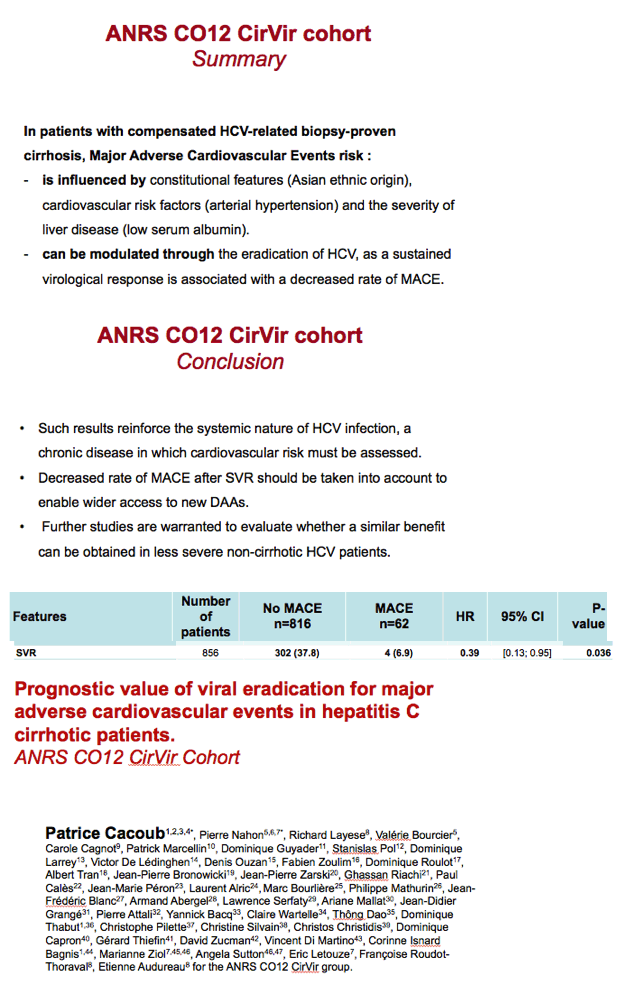
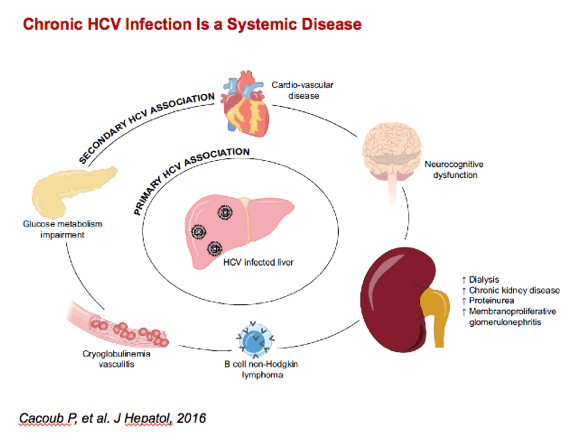
Program Abstract
Background and Aims: The objective was to identify predictive factors of and to examine the independent role of sustained viral response (SVR) on major adverse cardiovascular events (MACE) of patients with compensated hepatitis C virus (HCV) cirrhosis.
Methods: Patients with the following inclusion criteria were enrolled in 35 French centres between 2006 and 2012: a) biopsy-proven HCV cirrhosis; b) Child-Pugh A; c) positive viremia; d) no prior liver complication, and then were prospectively followed-up. All patients received HCV treatment after inclusion. MACE included stroke, myocardial infarction, ischemic heart disease, heart failure, peripheral arterial disease, cardiac arrest, and cardiovascular death. SVR, defined as a negative viremia 12 weeks post-treatment, was considered as a time-dependent covariate and its effect on MACE was assessed by Cox proportional hazards regression.
Results: 878 patients were enrolled between 2006 and 2012, 62 (7.1%) of whom presented a total number of 79 MACE after a median follow-up of 57.5 months. Overall survival at 5 years was 60.1% versus 87.5% in patients who did or did not present a MACE (P <.001). Causes of death in patients who experienced a MACE were mainly related to cardio-vascular disease in 7/22 (31.8%) cases, liver failure (5, 22.7%) and HCC (3, 13.6%). Main predictive baseline factors of MACE were Asian ethnic origin (HR = 7.25 [1.98; 18.90], P = .006), past history of MACE (HR = 5.43 [2.17; 11.38], P <.001), arterial hypertension (HR = 2.66 [1.61; 4.42], P <.001), diabetes mellitus (HR = 2.01 [1.17; 3.36], P = .013), current smoking (HR = 1.86 [1.03; 3.41], P = .041), low serum albumin level (HR =3.02 [1.61; 5.32], P < 001), high total bilirubin level (HR = 2.10 [1.23; 3.51], P = .007), and low platelet count (HR = 2.11 [1.17; 3.85], P = .013). At endpoint, a SVR was noted in 4 (6.9%) who did versus 302 (37.8%) patients who did not present a MACE (HR = 0.39 [0.13; 0.95], P = .036). In multivariate analysis, SVR was associated with a decreased risk of MACE (HR = 0.35 [0.09; 0.97], P = .044), while Asian ethnic origin, arterial hypertension, smoking and low serum albumin level remained predictive of MACE occurrence.
Conclusions: In patients with compensated HCV cirrhosis, Asian ethnic origin, arterial hypertension, smoking and low serum albumin are independent predictive factors of cardiovascular events occurrence, while a sustained virological response is associated with a decreased rate of cardiovascular events.
Lee MH, et al. J Infect Dis 2012;206:469-77
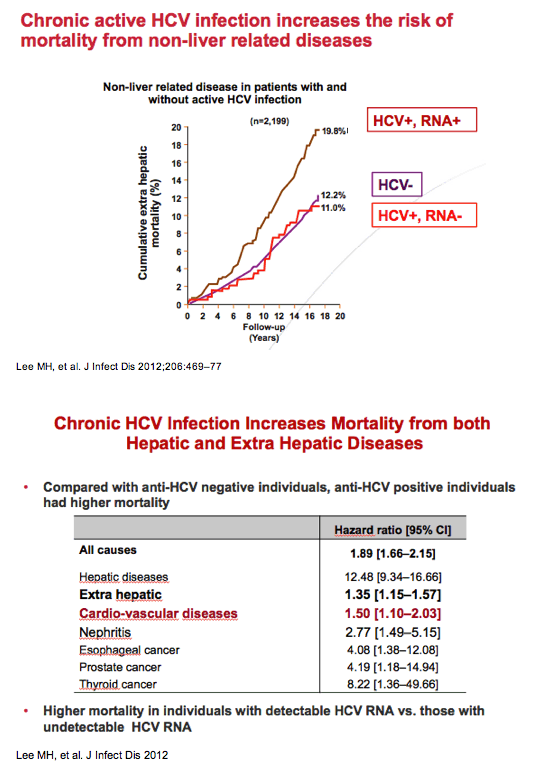
Program Abstract
Background and Aims: The objective was to identify predictive factors of and to examine the independent role of sustained viral response (SVR) on major adverse cardiovascular events (MACE) of patients with compensated hepatitis C virus (HCV) cirrhosis.
Methods: Patients with the following inclusion criteria were enrolled in 35 French centres between 2006 and 2012: a) biopsy-proven HCV cirrhosis; b) Child-Pugh A; c) positive viremia; d) no prior liver complication, and then were prospectively followed-up. All patients received HCV treatment after inclusion. MACE included stroke, myocardial infarction, ischemic heart disease, heart failure, peripheral arterial disease, cardiac arrest, and cardiovascular death. SVR, defined as a negative viremia 12 weeks post-treatment, was considered as a time-dependent covariate and its effect on MACE was assessed by Cox proportional hazards regression.
Results: 878 patients were enrolled between 2006 and 2012, 62 (7.1%) of whom presented a total number of 79 MACE after a median follow-up of 57.5 months. Overall survival at 5 years was 60.1% versus 87.5% in patients who did or did not present a MACE (P <.001). Causes of death in patients who experienced a MACE were mainly related to cardio-vascular disease in 7/22 (31.8%) cases, liver failure (5, 22.7%) and HCC (3, 13.6%). Main predictive baseline factors of MACE were Asian ethnic origin (HR = 7.25 [1.98; 18.90], P = .006), past history of MACE (HR = 5.43 [2.17; 11.38], P <.001), arterial hypertension (HR = 2.66 [1.61; 4.42], P <.001), diabetes mellitus (HR = 2.01 [1.17; 3.36], P = .013), current smoking (HR = 1.86 [1.03; 3.41], P = .041), low serum albumin level (HR =3.02 [1.61; 5.32], P < 001), high total bilirubin level (HR = 2.10 [1.23; 3.51], P = .007), and low platelet count (HR = 2.11 [1.17; 3.85], P = .013). At endpoint, a SVR was noted in 4 (6.9%) who did versus 302 (37.8%) patients who did not present a MACE (HR = 0.39 [0.13; 0.95], P = .036). In multivariate analysis, SVR was associated with a decreased risk of MACE (HR = 0.35 [0.09; 0.97], P = .044), while Asian ethnic origin, arterial hypertension, smoking and low serum albumin level remained predictive of MACE occurrence.
Conclusions: In patients with compensated HCV cirrhosis, Asian ethnic origin, arterial hypertension, smoking and low serum albumin are independent predictive factors of cardiovascular events occurrence, while a sustained virological response is associated with a decreased rate of cardiovascular events.
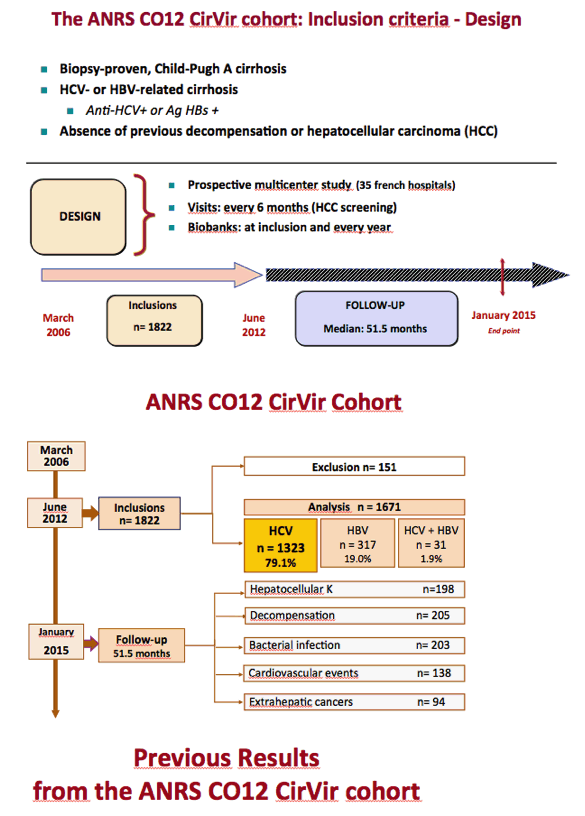
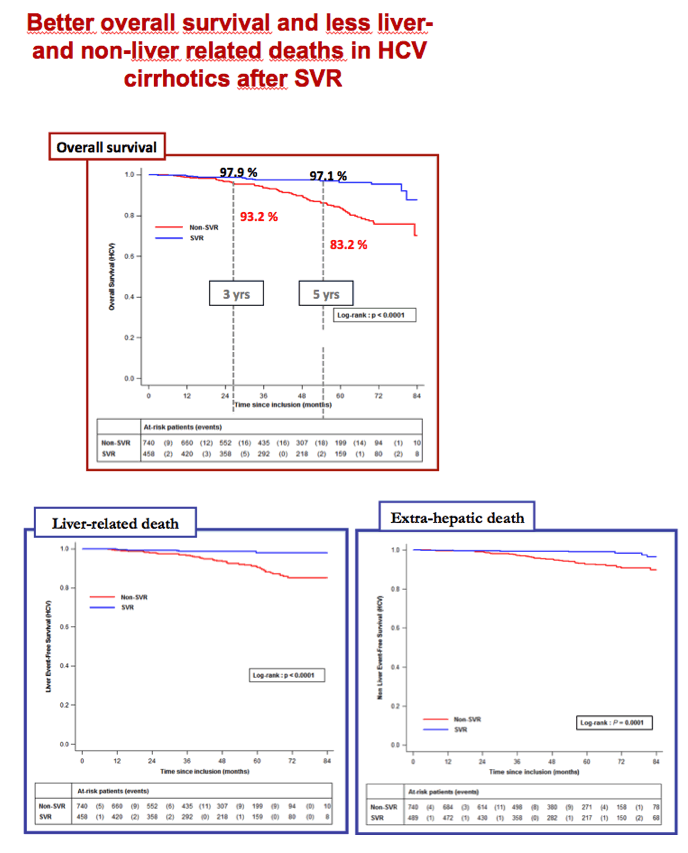
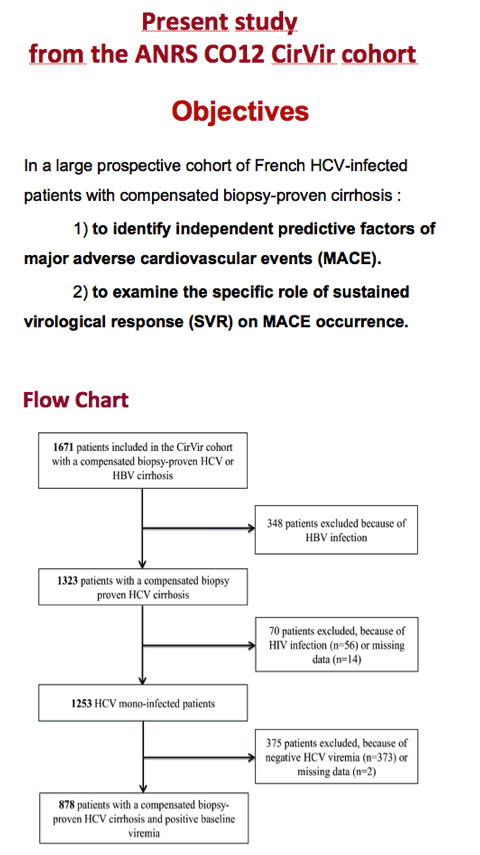
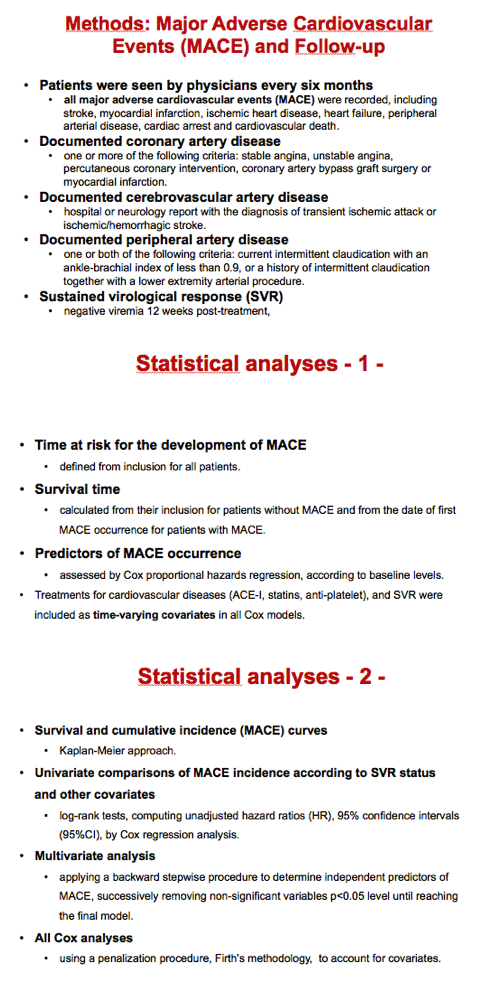
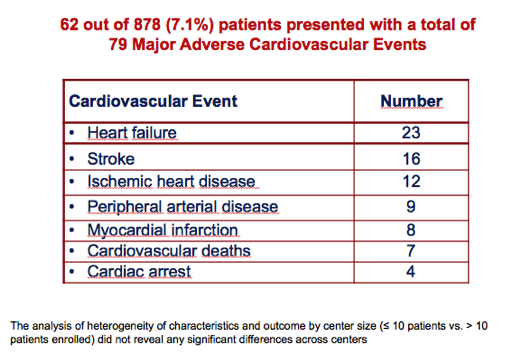


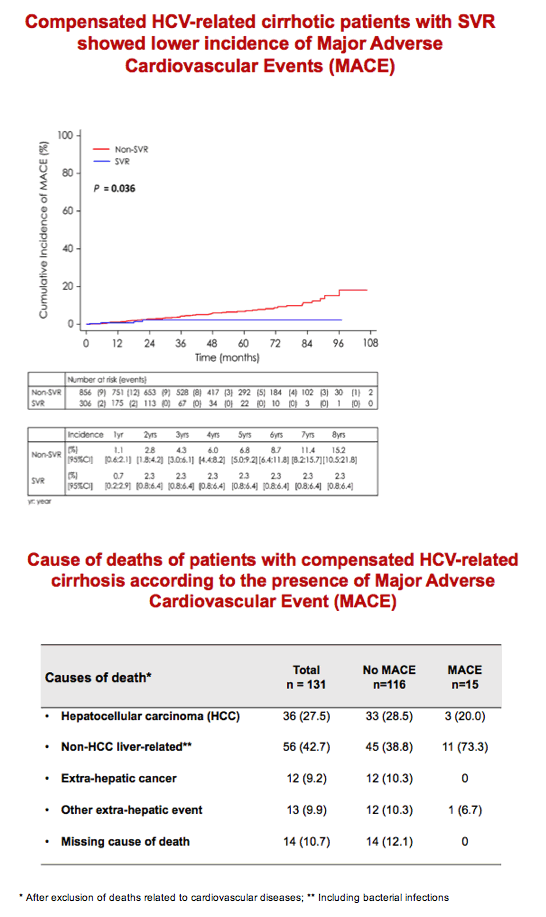

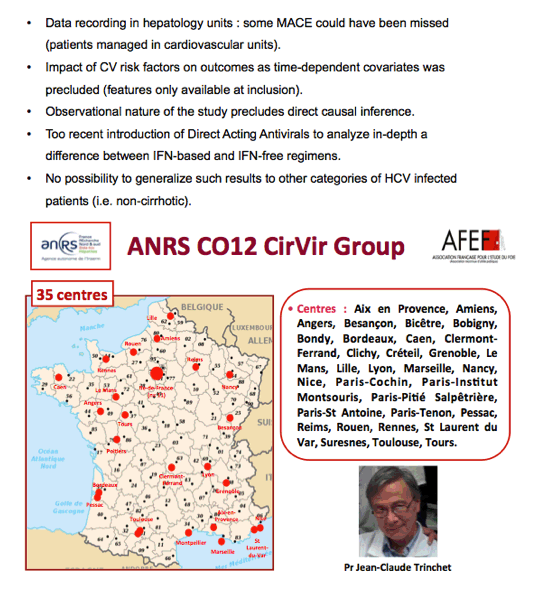
|
| |
|
 |
 |
|
|